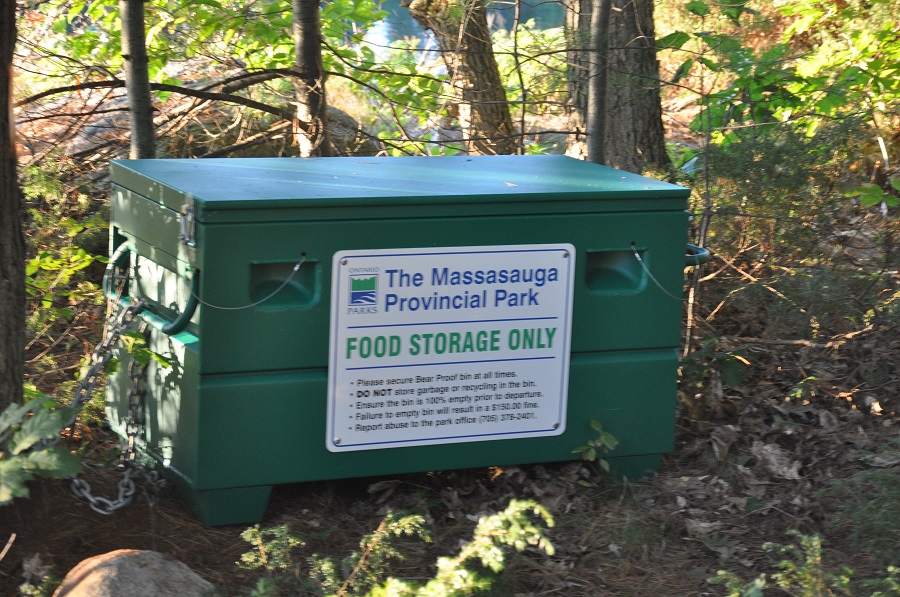We don’t know about you, but when we pack food for our backcountry trip, we plan on eating it.
That plan can go downhill quickly when raccoons, squirrels, and bears dip into your trail mix, or rain soaks through your pack, ruining your soft sausage buns.
You want to see a grumpy bear? A weekend away without food will turn us into one in no time!
Instead, learn how to store food and dispose of scraps so you don’t end up with soggy food or, worse, unexpected dinner guests.
How to pack your food
 Your canoe or hiking route might have a big say in how you pack your food.
Your canoe or hiking route might have a big say in how you pack your food.
If you’re a short paddle from your car, you may choose to pack a cooler. If you’re hiking, a backpack will do. If you’ve got a long portage ahead, a bear barrel with a harness could be the answer.
Talk to your local outfitter to pick the best storage container option for your trip.
Best ways to waterproof your food
With your container in tow, you’ll want to waterproof your inner food storage.
For obvious reasons, most cooking utensils won’t need waterproofing. However, food like bread, granola, oatmeal, coffee, and more aren’t going to last if rain clouds roll in.

Reusable plastic containers are a light-weight solution and keep your food fresh and dry. You could also use zip-bags for an air-tight seal (this is where we keep our toilet paper too).
Put your waterproofed food in your desired storage container and head out to the park!
How to store your food at camp
The day has finally come, and you’ve arrived at your designated site! If you’re like us, you’ve scouted your site, set up your tent, and picked the perfect food-hanging tree before settling in to cook dinner.
Wait, what’s the perfect food-hanging tree? It:
- is at least 100 metres from your sleeping area
- has a branch that is at least 4 m off the ground
- allows you to hang your food and garbage at least 2 m from the tree trunk
These measures keep bears, raccoons, and more from climbing the tree and accessing your food. Worse yet, if left unattended on the ground or in a container that expels scent, you’re likely to end up with wildlife sniffing around, causing a hazard for you and them.
Some Ontario Parks sites have metal storage lockers to store your food, but not all. Do your research before you go.
After you’ve located the ideal tree, move all your food, garbage, toothpaste, bug spray, sunscreen, deodorant, and any other hygiene products into your food storage container.
Tie it securely with a rope, and hang it from the branch. Bring your own rope, and make sure it’s a minimum of 12 m long. Some savvy campers also bring a pulley with them to make the heave easier. Your food container should stay here throughout the trip whenever you’re not using it.
Most importantly, do not leave your food unattended or bring food, garbage, or body care products into your tent.
The safest way to dispose of your food
Hands down, the best method is to pack out your scraps with you. That goes for coffee grinds, bacon fat, apple cores, fish guts, and any other waste you produce on your trip.
Essentially, it should all be packed back up into your storage container, stored safely at camp, and brought out with you when you leave.
What about burning and burying?
- burying food scraps is ill-advised because wildlife will dig it up
- burying garbage is considered litter and prohibited
- burning paper items in your campfire is allowed
- avoid glass cans and containers as they are prohibited in many of our parks
- filter food scraps from dishwater and bury the grey water at least 20 cm deep and at least 30 m from camp and any water sources
We rely heavily on our visitors to clean up after themselves. If you happen upon garbage in the backcountry, please pack it out with you.
That’s it!
Now that you’ve put your priorities straight and protected all those tasty snacks (food = life), you’re ready to make a meal plan.
For more backcountry resources, check out these blogs.


